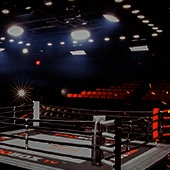The 2.7m statue of Joe Frazier is nearing completion and is expected to be unveiled in April next year.
Artist Stephen Layne, who has been working in the statue since March, plans to finish the clay work by the end of this month. It will then be moulded, cast in bronze and erected at an entertainment complex near three sports stadiums in Philadelpia.
Two of the former heavyweight champion’s daughters, Weatta Collins and Renae Martin, say they are thrilled with Layne's work. “It's really long overdue," Collins said this week. "We're happy that it's finally being done."
The statue, which will weigh 816kg, is unlike the Rocky statue in the same city.
Steering clear of the victorious, raised-arms stance of "Rocky", Layne found his motivation in a photograph of "Smokin' Joe" flooring Muhammad Ali with his powerful left hook. "That pose of glory, the Rocky pose, I don't think that's quite the vibe of Philadelphia," says Layne.
Busloads of tourists line up every day to take pictures at the statue of Rocky Balboa, the fictional heavyweight made famous by Sylvester Stallone. Whether visitors will line up for pictures with a sculpture of the real hometown champion is a question to be answered.
"Properly promoted, I think it would be much, much bigger than Rocky," says Robin Hazel, a visitor from Ottawa. "'Rocky' is great, it's a movie. But Joe Frazier's real. And he's Philadelphia."
The Frazier sculpture will be erected off the tourist track, about 8km south of the Rocky statue, which stands at the Philadelphia Museum of Art steps that Stallone ran up in a Rocky film.
Frazier’s family members are working with tourism officials to ensure sightseeing maps include the boxing memorial.
The plans to erect a statue of Frazier was first announced two years ago but almost ran aground because of fundraising problems and the sudden death of the original sculptor. Layne, 46, won the commission the second time around and began working in March.
The artist, who was raised in the city and studied at the Pennsylvania Academy of the Fine Arts, where he has also lectured, says he felt drawn to the Frazier project because of the shared Philadelphia connection.
"It was so obvious that he was completely willing to get beat up ... so that he could achieve what he wanted," Layne said. "And I thought that was just an inspirational thing to watch."
Frazier became the first fighter to beat Muhammad Ali when he outslugged "The Greatest" in a bout for the heavyweight title in 1971.
He had won a gold medal at the 1964 Olympic Games in Tokyo and finished with a professional record of 32-4, with one draw and 27 knockouts. Two of the defeats were memorable rematches with Ali, including the "Thrilla in Manila" in 1975.
When Frazier died of liver cancer three years ago at the age of 67, his place had long been cemented in sports history. Still, a public fundraising campaign for his memorial generated few contributions. Four donors provided most of the $160 000 for the statue and its maintenance fund.

